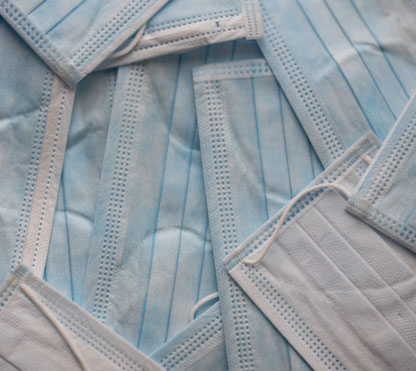Respirator Testing Requirements
What is a respirator?
A respirator is a tight-fitting filtering facepiece. It is designed to achieve a very close facial fit and very efficient filtration of airborne particles, including dust particles and infectious agents, gases, or vapors. Wearer’s nose and mouth will be at least covered by the edges of the respirator in a tight seal. This gives good breathability to wearers as the facepiece does not collapse against the mouth.
Respirator is categorized into four types: particulate respirator, “gas mask”, airline respirator and self-contained breathing apparatus. Particulate respirator is most commonly used for COVID-19 prevention as it intends to filter out airborne particles, the category can be further divided into six types as table below:
| EN 149 Class | NIOSH 42 CFR 84 Class | Particle Filtration | Typical Use |
| FFP1 | Protect against low levels of dust, as well as solid and liquid aerosols. Dust Masks are suitable for hand sanding, drilling, and cutting | ||
| FFP2 | >=94% | Usually disposable and may be used in construction and by healthcare professionals against influenza viruses. | |
| N95/R95/P95 | >=95% | Minimal level of protection approved for medical use | |
| FFP3 | N99/P99 | >=99% | Suitable for handling hazardous powders, such as those found in the pharmaceutical industry |
| >N100/P100 | Protect workers from exposure to dust, fumes and hazardous mists. They also provide protection against contagious disease | ||
| Medical Use | For surgical situations. Additional testing such as bacterial filtration test and fluid resistance test under EN 14683 or ASTM F2100 required. | ||
Similar to medical masks, respirators that are designed to prevent transmission of disease are subject to strict regulatory standards in different countries before being made commercially available.
Regulatory Compliance requirements in different markets:
| Market-Specific Regulatory Compliance | ||||
| Country | Primary Regulation | Performance Standard | Classification | Requirement |
| Australia | AS/NZS 1715:2009 | AS/NZS 1716:2012 | P3 | ≥99.95% |
| P2 | ≥94% | |||
| P1 | ≥80% | |||
| Brazil | Fundacentro CDU 614.894 | ABNT/NBR 13698:2011 | PFF3 | ≥99% |
| PFF2 | ≥94% | |||
| PFF1 | ≥80% | |||
| Canada | - | - | N95 | Non-oil aerosol ≥95% |
| N99 | Non-oil aerosol ≥99% | |||
| N100 | Non-oil aerosol ≥99.7% | |||
| R95 | Oil aerosol ≥95% | |||
| R99 | Oil aerosol ≥99% | |||
| R100 | Oil aerosol ≥99.7% | |||
| P95 | Oil aerosol ≥95% | |||
| P99 | Oil aerosol ≥99% | |||
| P100 | Oil aerosol ≥99.7% | |||
| - | - | Surgical N95 | ≥95% | |
| China | GB/T 18664—2002 | GB 2626-2019 | KN90 | Salt aerosol ≥ 90% |
| KN95 | Salt aerosol ≥ 95% | |||
| KN100 | Salt aerosol ≥ 99.97% | |||
| KP90 | Oil aerosol ≥ 90% | |||
| 95 | Oil aerosol ≥ 95% | |||
| 100 | Oil aerosol ≥ 99.97% | |||
| NMPA | GB 19083-2010 | Level l | Non-oil aerosol ≥95% | |
| Level II | Non-oil aerosol ≥99% | |||
| Level III | Non-oil aerosol ≥99.97% | |||
| EU | (EU) 2016/425, EN 529:2005 | EN 149:2001+A1:2009 | FFP3 | ≥99% |
| FFP2 | ≥94% | |||
| FFP1 | ≥80% | |||
| India | - | IS 9473:2002 | FFP3 | Salt aerosol ≥97% and Oil aerosol ≥ 99% |
| FFP2 | Salt aerosol ≥94% and Oil aerosol ≥98% | |||
| FFP1 | Salt aerosol ≥80% | |||
| United States | OSHA 29 CFR1910.134 | NIOSH: 42 CFR 84 | N95 | ≥95% |
| N99 | ≥99% | |||
| N100 | ≥99.7% | |||
| R95 | ≥95% | |||
| R99 | ≥99% | |||
| R100 | ≥99.7% | |||
| P95 | ≥95% | |||
| P99 | ≥99% | |||
| P100 | ≥99.7% | |||
| OSHA: 29 CFR 1910.134 | NIOSH: 42 CFR 84 | Surgical N95 | ≥95% | |
| FDA: 21 CFR 878.4040 | ASTM F2100 | ≥95% | ||
Key testing parameters
While there are many testing parameters for measuring the quality and performance attributes of respirators, below are key testing parameters to take note of:
| Test Parameter | Test Objective | Measurement |
| Bacterial Filtration Efficiency (BFE) | Resistance of the mask against bacterial agents | Results are reported as percentage efficiency rating. The higher the number in this test indicates better barrier efficiency |
| Particle Filtration Efficiency (PFE) | Resistance of the mask against particles larger than 1 micron | Results are reported as percentage efficiency rating. The higher the number in this test indicates better filtration efficiency* |
| Fluid Resistance Testing | Resistance of the mask against liquid splashes such as blood or other bodily fluids | Results are reported as pressure with or without any fluid penetration observed at the back side of mask. The higher value without penetration indicates better resistance. |
| Breathability Testing - Differential Pressure | Easiness of the wearer to breath comfortably in the mask | Lower breathing resistance indicates a better level of comfort for the wearer |
| Microbial Cleanliness | Total number of viable micro-organism on the mask | Results are reported in units of micro-organism, lower the value more cleanliness |
*higher filtration efficiency also indicates higher difficulty for air to pass through the mask. In this case, breathability testing is recommended.

